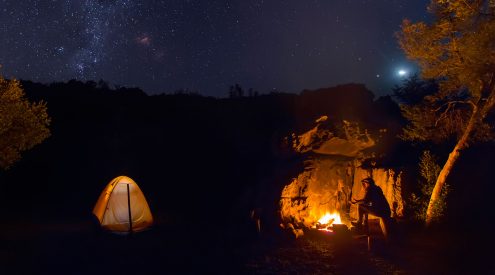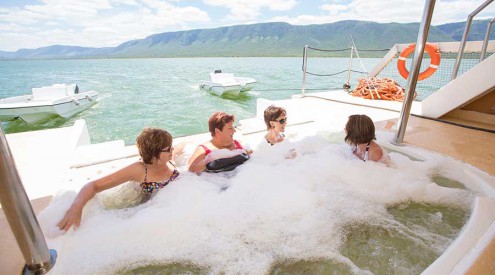We’re standing under the overhang of a shaman’s cave in the Cederberg. A gallery of ochre figures was painted in this shelter thousands of years ago. Stumbling across rock art sites in these ancient mountains conveys a magical sense of discovery – as if we could be the first to come across the evidence left by the original inhabitants, the San (/Xam) who sought sanctuary in these mountains eons ago.
Simone Wood-Callander, one of the knowledgeable rangers at Bushmans Kloof Wilderness Reserve, is interpreting the paintings at Brandhoek, one of over 130 sites in the area. Time travelling into the past, we look up at a mantis-headed goddess (a voluptuous figure with shapely calves) dominating a tableau of tiny stick figures carrying bows and arrows, quivers, hunting bags and digging sticks. Another shelter nearby is covered in small ochre hand prints – as if drawing on the energy of these ancient rocks. We can feel the spiritual presence of those who came before us.
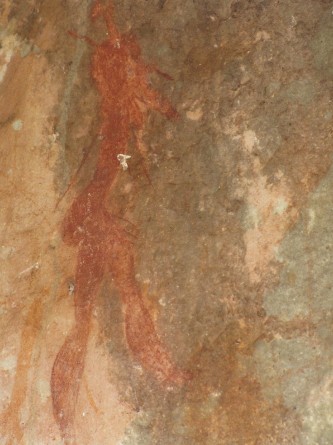
No-one remains behind to tell their story. Scholars began recording their oral history a century ago – and speculate about the spiritual trance sites of the Cederberg. We use our imagination to conjure up the /kaggen (the mantis), the creator of the /Xam people, the bringer of fire and tools, the immortal figure of San legend who has immense powers and changes form. The mantis is a trickster of note who appears as an old man, travels on the sacred eland and talks in the clicks of these ancient people. To learn more, read Anne Rogers blog on her new book The Mantis Chronicles.
On the way back to the lodge, the Land Rover and the radio momentarily fail to work – and an eerie silence falls on our party. We’re all a bit spooked by the powers of the mantis. I joke about Peter Weir’s Picnic at Hanging Rock, the film about schoolgirls who vanished into mystical rocks in the Australian outback – never to be seen again. Then the engine kicks into life, the radio crackles and the spell of the trickster breaks.

Bushmanskloof Wilderness Reserve is set in a spectacular landscape of mountains – the towering Krakadouw, Biedouw and the delightfully named TraTra Mountains. The peaks have evocative names from Citadel Kop and Horlosie Kop to Moer Kop (read: Cederberg hikes you probably didn’t know about). The game the San hunted has returned to the Cederberg since Bushmans Kloof turned back the clock twenty years ago. I have come here frequently over the years and experienced a sense of wilderness returning to what were old rooibos farms.
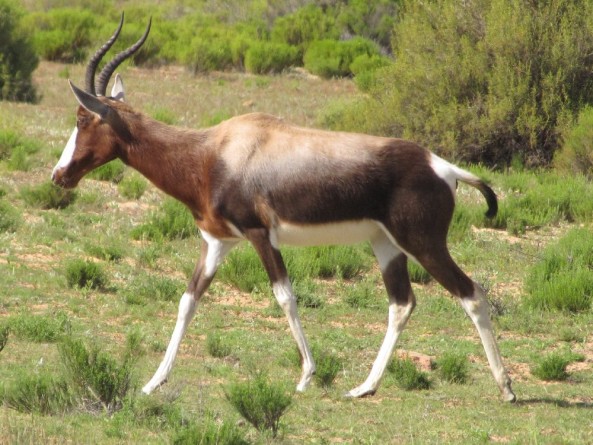
On one of the daily game and rock art drives, we spotted shy bontebok, pronking springbok, klipspringer, red hartebeest (“named after the horns shaped like a heart” reckons Simone), wildebeest (“named gnus after the nasal sounds they make”), ostrich and bat-eared foxes. Simone stops to talk about the flora as well – in an area where the mountain fynbos kingdom meets the succulent Karoo. The veld is a carpet of bright yellow Clanwilliam daisies, gousblom, proteas and vygies – a kaleidoscope of wild flowers marking the advent of Spring. The San once weaved baskets out of the restio reeds and used many of these wild herbs and plants for cooking and medicine.
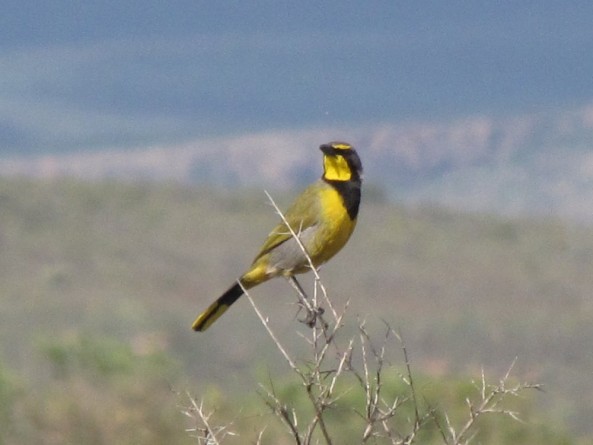
Time stood still as we stopped to listen to a lonely yellow and black bokmakierie calling out for a duet “kok-o-viet”, “bok-bok-chit”, “wit, wit wit” (pretty witty).
We spotted a few of the 130 spies of birds and 35 mammals identified in the reserve on the Bushmans Kloof checklist – and fell asleep in one of the thatched suites to the hoot of Cape eagle owls who live in the giant blue gums. The busy little male weavers spend every waking hour building nests in the same trees to attract their mates in a timeless ritual. Before dinner, manager James Basson showed us the more elusive animals captured on camera at Bushmans Kloof – an aardvark, a curious baboon, and one of four rare leopards fitted with GPS tracking collars. Bushmans Kloof works closely with the Cape Leopoard Trust and owns the largest private herd of the rare Cape Mountain Zebra. You can follow the camera at www.bushmanskloof.co.za
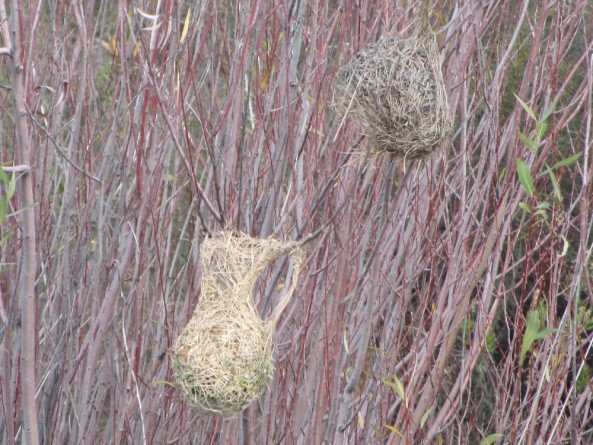
Set in a natural amphitheatre under Horlosiekop – they say you can tell the time by the shadow of the sun on the mountain peak – Bushmans Kloof wilderness lodge is a sanctuary with a very special sense of place (read about a 3-day yoga retreat at Bushmans Kloof here). The Boontjies River runs through it, cascading down from the plateau and creating a tranquil Zen feel around the lodge, manor house, spa, pools, luxury cottages and gardens. This Relais and Chateaux lodge was voted one of the top 50 resorts in Africa by Conde Nast Traveler, #1 in Africa by Travel & Leisure and a top eco-lodge by National Geographic Traveler.

Using local produce and organic free-range ingredients, chef Floris Smith showcases the bio-diversity of the Cederberg on a unique menu inspired by the Cape floral kingdom. After spending the days in the great outdoors under the big skies of the Cederberg, we brought big appetites to brunch and dinner. I especially enjoyed dishes marked with an F (for fynbos ingredients) and R (rooibos) – indulging in salmon cured in fynbos, quail smoked in wild rooibos and ostrich carpaccio rolled in wild rosemary. Chef enjoys foraging in the walled fruit and vegetable gardens (as do baboons).
The weekend we visited Bushmans Kloof, winemaker Peter Finlayson presented a tasting of his Bouchard Finlayson wines from the Hemel-en-Aarde Valley above Hermanus. Over an intimate fireside tasting in the homestead, a full-house of 24 guests were treated to rare old vintages of award-winning Galpin Peak Pinot Noir from 1997 – 2009. He spoke about his passion for “the heartbreak grape” of Burgundy – “the most challenging of all red varieties” – and the quest to express the cool climate terroir of Pinot Noir he has made in the Walker Bay region over thirty vintages.

Chef Floris Smith created a fabulous food and wine pairing menu which showcased the current releases of Bouchard Finlayson – matching the reserve Sauvignon Blanc 2010 with salmon sushi with wasabi and white chocolate (“a picture on a plate”), Hannibal 2011 (if only the elephants in the rock art were still around in the Cederberg today) with a trio of duck, Galpin Peak Pinot Noir 2011 with slow-braised lamb ravioli and Missionvale Chardonnay2011 with brie and gorgonzola blueberry cheese cake. Over another weekend, Dawid Niewoudt of Cederberg Wines presented his wines off an award-winning wine list showcasing local Olifants River and other wine regions.
Who could ask for more? I fell asleep in a four-poster bed dreaming of the praying mantis – and wondering if we’d visit Bella’s Cave, Sonya’s Cave, Bleeding Nose or Fallen Rock – four of my favourite rock art sites at Bushmans Kloof. I remembered what the old man living at Boontjieskraal told visitors who asked why he lived in such a remote place: “This is where the world began and this is where the world will end”. The Cederberg is an ancient place of power and magic which has drawn shamans for centuries.
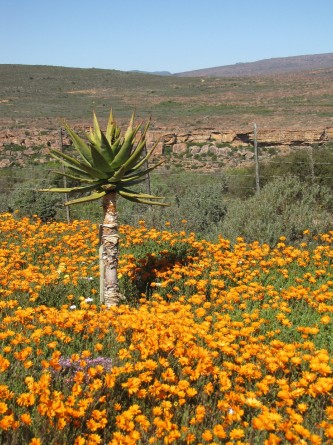
* During the winter season, Bushmanskloof holds special weekends themed on food and winemakers, flowers, gardening, astronomy and adventure. For rates and events, contact 021 437 9278, [email protected] or see www.bushmanskloof.co.za
Find more great options for accommodation in the Cederberg here.









